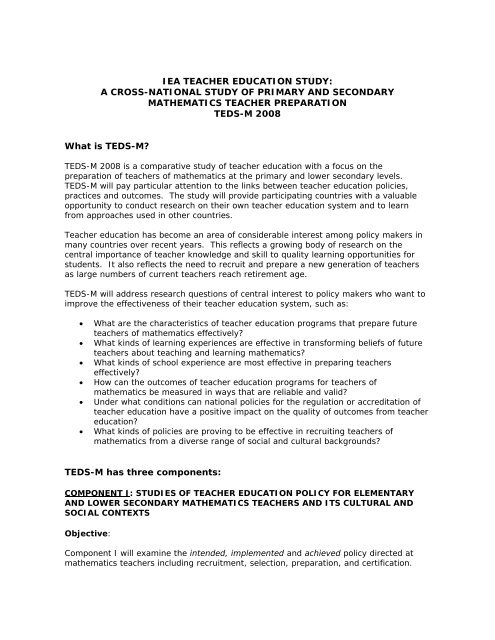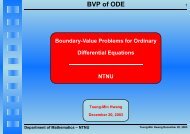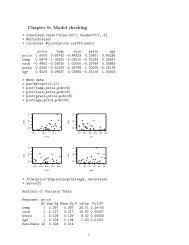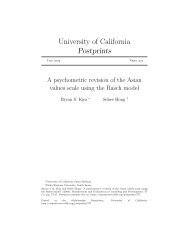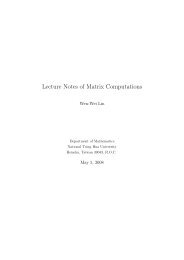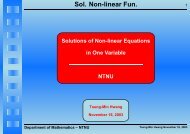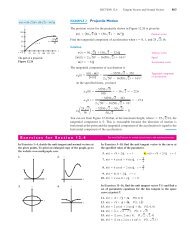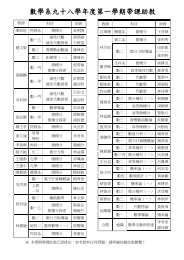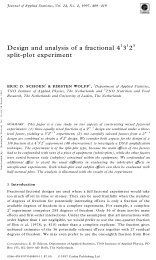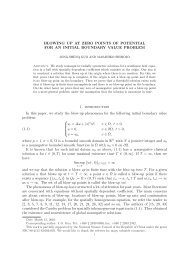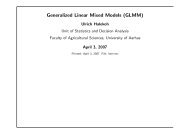IEA TEACHER EDUCATION STUDY - Taiwan TEDS-M 2008
IEA TEACHER EDUCATION STUDY - Taiwan TEDS-M 2008
IEA TEACHER EDUCATION STUDY - Taiwan TEDS-M 2008
- No tags were found...
You also want an ePaper? Increase the reach of your titles
YUMPU automatically turns print PDFs into web optimized ePapers that Google loves.
COMPONENT II: STUDIES OF ELEMENTARY AND LOWER SECONDARYMATHEMATICS <strong>TEACHER</strong> PREPARATION ROUTES, PROGRAMS, STANDARDS ANDEXPECTATIONS FOR <strong>TEACHER</strong> LEARNINGObjective:To examine the intended and implemented curriculum of teacher education.Questions:(a) What kinds of institutional and field-based opportunities are provided for futureprimary and lower secondary mathematics teachers?(b) How are program expectations, curriculum and standards enacted?(c) What are the qualifications and prior experiences of the university mathematicslecturers/professors/teachers and teacher educators responsible for implementation ofthese programs?(d) What factors explain how much impact routes, programs and practices have on themathematics knowledge of future teachers of mathematics?Data collection instruments:a) Institutional Questionnaire of Teacher Preparation Programs The questionnairewill ask questions regarding the nature and depth of mathematics taught to futureteachers in general education and in the professional curriculum; the kind of programfuture mathematics teachers follow (e.g., consecutive or concurrent); the standards forteacher preparation in mathematics; the kinds of assessments and the level ofperformance required; and the pedagogical preparation, and mathematics-specificpedagogical preparation. It will also include questions on resources used to operateteacher education programs, and a general profile of teacher educators (e.g.,credentials, professional path, courses taught). In case where the country has aconsecutive route, only future teachers in the last year of teacher education will besurveyed, and their knowledge of mathematics will be approximated from the study ofthe national curriculum.<strong>TEDS</strong>-M WILL SAMPLE INSTITUTIONS: National probability sample of teachereducation institutions in each countryIn countries where institutions offer both elementary school and secondary schooleducation, one list and one sample combining elementary and secondary schools willsuffice for each route. Similarly, some institutions may offer more than one route. Insuch cases, the frame should be organized by the number of routes an institution offers.Some countries may opt to select a cohort of beginning students. In that case, the largerof the two cohorts should be used as a measure of size.Target Population: A secondary or post-secondary institution offering opportunities tolearn (OTL) to future elementary and secondary mathematics teachers within a majorroute.Sampling Frame: Identification of routes that can lead to elementary and secondaryschool teaching; within each route, identify eligible institutions within target population,with some measure of size (e.g. number of future elementary and/or secondary school3
teachers in their final year’s cohort.). If the figures for primary and secondary grades aredifficult to obtain, use readily available figures for the total size of these populations atelementary or lower secondary levels. Include required stratification variables.Sample Design: Stratification by additional attributes, such as type of institution,urban/rural setting, sub-national region or administrative jurisdiction. Selection using astratified PPS systematic sample design. National conditions may make this designchoice impractical, in which case the national design must be approved by the samplereferee in agreement with the <strong>TEDS</strong>-M Joint Management Committee.Sample size: At least 50 institutions from each route. Countries with much smallernumbers of institutions will conduct a census. Countries with much larger numbers ofinstitutions will sample institutions.b) Questionnaire for Mathematics Instructors and Teacher Educators Thisquestionnaire will collect data from mathematics instructors and teacher educators ontheir background, their mathematics teaching knowledge, the materials used ininstruction, their espoused theories for teacher change, and their expectations for theirfuture teachers. Parts of this questionnaire will be similar to the Future TeacherQuestionnaire, as we propose to examine correspondence and differences betweenfaculty and future teachers (on such things as knowledge, pedagogy, and beliefs) as anindicator of coherence and its possible effects on teacher education impact on outcomes.<strong>TEDS</strong>-M WILL SAMPLE INSTRUCTORS: Sample of mathematics instructors andteacher educatorsIf sub-sampling of instructors is deemed required or appropriate, a list of the eligibleinstructors must be drawn and a sample plan must be submitted for acceptance.Target Population: Persons with regular, repeated responsibility to instruct or mentorfuture elementary and lower secondary mathematics teachers within a given route.Sampling Frame: Establish list of eligible instructors at each sampled TE/TL institutionwith a minimum of four strata as follows: (1) instructors of mathematics whose primaryresponsibility is to teach the content of mathematics; (2) teacher educators whoseprimary responsibility is to help students understand the pedagogy and learning ofmathematics in elementary and/or secondary schools; (3) other teacher educators inacademic component; (4) other teacher educators in field experience component. Thesefour strata applies to instructors of both elementary and lower secondary future teacherswhen appropriate.Sample Design: All eligible instructors within sampled institutions will be surveyed.National conditions may make this design choice impractical, in which case the nationaldesign must be approved by the sample referee in agreement with the <strong>TEDS</strong>-M JointManagement Committee.Sample size: In nearly all institutions it is expected that the number of eligibleinstructors will be too small for sub sampling in at least one and frequently more thanone of the strata. Sub sampling will be used only when the n within the stratum of asampled institution is larger than needed and overly burdensome to survey.4
c) Content Analysis of the Teacher Education Mathematics Curriculum A protocolwill be developed to analyze syllabi and sample assignments from the teacher educationmathematics curriculum in relation to mathematics standards for primary andsecondary students in the participating country and to the TIMSS international databaseof mathematics content standards. In addition, the protocol will examine the relationbetween the content covered and performance expectations of courses in themathematics teacher education curriculum and the local or national examinations forteacher certification or licensing. Such analyses will produce an initial profile of theimplemented curriculum in mathematics teacher education in terms of the knowledge,pedagogy, dispositions and other knowledge future teachers are exposed to as they getready to teach.What is required from NRC: The NRC will be responsible for gaining entrance tothe teacher preparation institutions, and finding the most appropriateperson(s) to answer the institutional questionnaire. NRC will need to have adedicated investigator per institution to administer surveys to the instructors,and to help gain access to the implemented curriculum (e.g., syllabi, texts andexaminations used in the program by the selected instructors). The NRC will dothe teacher education curriculum analysis according to agreed upon guidelines.5
Sampling Frame: List of eligible students in their last year of training from eachsampled institution within identified routes. If following the national option, futureteachers will be stratified by their annual cohort. In institutions that prepare teachers forboth primary and lower secondary schools, there is a need to sub-sample for bothdomains.Sample Design: The simplest approach will consist in equal size simple randomsampling of eligible future teachers from the sampled institutions.Sample size: An effective national sample size of 400 future primary and secondaryteachers for each route is desired.What is required from NRC: In addition to implementing the sample design, theNRC will be responsible for appointing a researcher to institutions to organizethe application of the survey of future teachers in their last year in teachereducation.Research Design and Methodology for the <strong>TEDS</strong>-M studyThe study surveys future teachers at the end of their teacher preparation to studyelementary and lower secondary teacher mathematical knowledge and its relationshipwith future teachers’ opportunity to learn. The study provides for a national option thestudy of cohorts (one at the entry and one at the exit level of teacher preparation). Theoverall design for the study is discussed and justified in detail in the ConceptualFramework a 60 page long document submitted to GA members in October 2004 in theGA Meeting in Taipei and available from the <strong>IEA</strong> Secretariat. In consultation withparticipating NRCs, this document will be revised for final publication by <strong>IEA</strong> in 2006. Thedata collection will be standardized according to <strong>IEA</strong>’s data collection quality standardsand will use – among others – On-Line Data Collection Tool.<strong>TEDS</strong>-M WILL USE NATIONAL PROBABILITY SAMPLES AND A CUSTOMIZEDSAMPLE PLAN FOR EACH PARTICIPANT COUNTRYOne of the paramount principles of <strong>IEA</strong> design is to base cross-national comparisons onnational probability samples. This approach includes development of an internationalmaster sampling plan, adaptation of this master plan to national contexts, andadjudication of differences by an <strong>IEA</strong> designated sampling referee. The <strong>TEDS</strong>-M willsample teacher education institutions, instructors and future teachers.What will be learned from <strong>TEDS</strong>-M?• <strong>TEDS</strong>-M provides answers on the POLICY AND CONTEXT of mathematicsteacher education:<strong>TEDS</strong>-M will study the intended and implemented policies that support primary and lowersecondary teachers’ achieved level and depth of mathematics and related teachingknowledge, and how teacher policies influence the structure of primary and lowersecondary mathematics teachers’ opportunities to learn.7
• <strong>TEDS</strong>-M provides answers on the ORGANIZATION of mathematics teachereducation:<strong>TEDS</strong>-M will study the learning opportunities available to prospective primary and lowersecondary mathematics teachers which allow them to attain the knowledge they need toteach mathematics. It will also study the structure of the opportunities, the contenttaught in teacher education programs, and the organization of instruction.• <strong>TEDS</strong>-M provides answers on the OUTCOMES of mathematics teachereducation:<strong>TEDS</strong>-M will study the level and depth of the mathematics and related teachingknowledge attained by prospective primary and lower secondary teachers, and how thisknowledge varies across countries.What value will the <strong>TEDS</strong>-M study add to existing research on teachereducation?<strong>TEDS</strong>-M is the first mathematics teacher education study to follow a rigorousmethodology to:• Gather empirical data on the experience of the participating countries tocontribute to policy debate over the nature, benefits and costs of teachereducation;• Strengthen the knowledge base to address participating countries’ nationalpriorities;• Develop concepts, measurement strategies, indicators and instrumentation tostrengthen the research in this field;• Further a more scientific approach to the study of teacher education and teacherlearning in mathematics.THE <strong>TEDS</strong>-M FINAL REPORT WILL BRING TOGETHER THE THREE COMPONENTSThe route and institutional profiles of teacher education, the institutional questionnaire,the curricular analysis, and the instructor / teacher educator data will provide aninstitutional and larger contextual frame for the analysis of program data collected in thisstudy. These data will help to refine key concepts, and to clarify the theorized coherenceand further analysis across and within programs as they influence teacher knowledge(via curriculum and instruction). We will use flow diagrams indicating the sequence ofprogram actions; and organizational schemes indicative of the resources--material,financial, personnel--that programs require to work as intended. The data collected fromthe Future Teacher Questionnaires will be correlated with the institutional data in orderto construct profiles of the intended, implemented, and achieved curriculum formathematics teachers by country, route, and institution.8
HOW LONG IS <strong>TEDS</strong>-M?The study will span four years: 1Oct 2005- Sept 2006• Revision and publication of conceptual framework document (D);• Initiation of national studies of policy and curriculum analysis;• Initiation of meta-analysis on mathematic teacher education effectiveness;• Review, adaptation of P-<strong>TEDS</strong> instruments, and piloting of additional items;• Design of national <strong>TEDS</strong>-M probability samples of TE institutions, futureteachers and the instructors of future teachers (D).• Two NRC meetings:13 – 16 February 2006, Hamburg,03 – 08 September 2006;Oct 2006-Sept 2007• Submission of national reports on policy studies and curriculum analysis (D);• Draft, review and release meta-analysis on mathematic teacher educationeffectiveness (D);• Draft, review and release of final international report on national policystudies (D);• Draft, review and release of final international report on curriculum analysis(D);• Finalization of instruments for triple survey (institutional, mathematicsinstructor / teacher educator, and future teacher) with field trial ofinstruments and procedures; execution of sample designs (D);• Manuals for triple surveys (D);Oct 2007-Sept <strong>2008</strong>• Main data collection in Southern Hemisphere;• Main data collection in Northern Hemisphere;• Entering, scoring, cleaning, weighting and scaling of data;• Analysis of data;•Oct-<strong>2008</strong>-Sept 2009• Review of draft international report;• Release of final international report (D);• Release of international data base and users guide (D);(D)=DELIVERABLESHOW IS <strong>TEDS</strong>-M MANAGED?1 We plan to gain additional funding for a study of beginning teachers to follow the <strong>TEDS</strong>-M study proposed herein, toextend the measures of the achieved curriculum of teacher education to the first years of teaching.9
• The <strong>TEDS</strong>-M Joint Management Committee (JMC) oversees the entire <strong>TEDS</strong>-Meffort.• This committee is responsible for overall project planning as well as for ensuringsound financial, personnel and logistical management, as well as accountability to<strong>IEA</strong> and the funding agencies.• The JMC reports to the <strong>IEA</strong> General Assembly, Standing Committee, and TechnicalExecutive Group on behalf of <strong>TEDS</strong>-M.HOW DO <strong>TEDS</strong>-M <strong>2008</strong> and OECD Teacher Survey 2007 COMPARE?The <strong>IEA</strong>-<strong>TEDS</strong>-Mathematics Study and the OECD Teacher Survey are two projects thatcomplement each other and are very different. While <strong>TEDS</strong>-M’s focus is on the empiricalstudy of Teacher Education effects on future primary and secondary mathematicsteachers, OECD’s Teacher Survey focuses on a meta-analysis on instructionaleffectiveness and processes and seeks to develop indicators on school and teachereffectiveness. As the first project to ever attempt to undertake the study of thepreparation of future primary and secondary mathematics teachers <strong>IEA</strong>-<strong>TEDS</strong>-M hassome unique features:FEATURES UNIQUE TO <strong>TEDS</strong>-Mathematics <strong>2008</strong>• <strong>TEDS</strong>-M study of Mathematics Teacher Education will survey: institutions,instructors, and future teachers.• Collects curriculum information on mathematics teacher preparation forprimary and secondary teachers allowing establishing links between theorganization and content of teacher preparation and outcomes.• National probability samples of institutions and future teachers enablematching future teachers’ knowledge to the instructional practices in teacherpreparation.• Optional cohort design provides information about the level of mathematicspreparation required for entering teacher education and the value added ofteacher preparation at graduation.• Reports knowledge of mathematics, mathematics pedagogy, pedagogy andbeliefs of future mathematics teachers describing what teachers learn andallowing for the establishment of international benchmarks.• Compares teacher education curriculum with primary and secondary schoolmathematics curriculum in terms of standards and examinations thusestablishing levels of consistency between what teachers learn and what theyare asked to teach.• Studies costs of teacher to document what would be the costs of improvingmathematics teacher preparation and the comparative costs of implementingalternative teacher education policies in different contexts.• Valuable tool for developing indicators on effective mathematics teacher10
preparation for primary and secondary teachers.• Valuable tool for designing mathematics teacher preparation policy for futuremathematics primary and secondary teachers.• <strong>TEDS</strong>-M is an in depth teacher education study that will produce heuristics forfuture in-depth studies of teacher preparation in all other school subjects.For more information on the study please contact:• The <strong>IEA</strong> Secretariat at: department@iea.nl• Study Co-director Maria Teresa Tatto at: mttatto@msu.eduAAPoliciesPoliciesBBElementaryElementary and secondary andsecondary schoolschoolcurriculumcurriculumCOther contextualfactors, includinglabor marketconditions and statusof teachingEDPriorcharacteristicsandexperiencesconcerningmathematicsand teachingThe OTLembodied inroutes,approaches& programsfor futureteachersFFutureTeacherKnowledgeGThe OTLembodied inroutes,approaches& programsforbeginningteachersHBeginningTeacherKnowledge11


